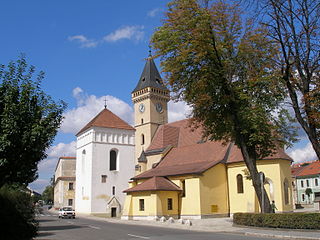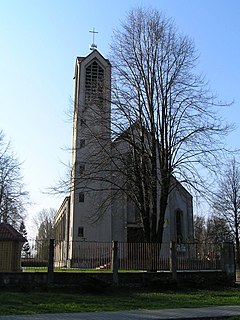
Nazi Germany built extermination camps during the Holocaust in World War II, to systematically kill millions of Jews, Slavs, Poles, Roma, Soviet POWs, political opponents and others whom the Nazis considered "Untermenschen" ("subhumans"). The victims of death camps were primarily killed by gassing, either in permanent installations constructed for this specific purpose, or by means of gas vans. Some Nazi camps, such as Auschwitz and Majdanek, served a dual purpose before the end of the war in 1945: extermination by poison gas, but also through extreme work under starvation conditions.

Camp Westerbork was a transit camp in Drenthe province, northeastern Netherlands, during World War II. Established by the Dutch government in the summer of 1939, Camp Westerbork was meant to serve as a refugee camp for Jews who had illegally entered the Netherlands.

Bełżec was a Nazi German extermination camp built by the SS for the purpose of implementing the secretive Operation Reinhard, the plan to eradicate Polish Jewry, a key part of the "Final Solution" which entailed the murder of some 6 million Jews in the Holocaust. The camp operated from 17 March 1942 to the end of June 1943. It was situated about 0.5 km (0.31 mi) south of the local railroad station of Bełżec, in the new Distrikt Lublin of the semi-colonial General Government territory of German-occupied Poland. The burning of exhumed corpses on five open-air grids and bone crushing continued until March 1943.

Sobibor was a Nazi German extermination camp built and operated by the SS during World War II near the railway station of Sobibór near Włodawa within the semi-colonial territory of General Government of the occupied Second Polish Republic.

Thomas "Toivi" Blatt was a Polish-American Holocaust survivor, writer of mémoires, and public speaker, who at the age of 16 escaped from the Sobibór extermination camp during the uprising staged by the Jewish Sonderkommando prisoners in October 1943. The escape was attempted by about 300 inmates, many of whom were recaptured and killed by the German search squads. Following World War II Blatt lived in the Soviet-controlled Poland until the Polish October revolution. In 1957, he emigrated to Israel, and in 1958 settled in the United States.

Karl August Wilhelm Frenzel was an SS non-commissioned officer in Sobibór extermination camp. As the commandant of Camp I, he supervised the Special squad of Jewish prisoners who were forced to handle the killing procedure and also herded the victims into the gas chambers.

Jewish resistance under the Nazi rule took various forms of organized underground activities conducted against German occupation regimes in Europe by Jews during World War II. According to historian Yehuda Bauer, Jewish resistance was defined as actions that were taken against all laws and actions acted by Germans.The term is particularly connected with the Holocaust and includes a multitude of different social responses by those oppressed, as well as both passive and armed resistance conducted by Jews themselves.

Herzogenbusch concentration camp was a Nazi concentration camp located in Vught near the city of 's-Hertogenbosch, Netherlands. Herzogenbusch was, with Natzweiler-Struthof in occupied France, the only concentration camp run directly by the SS in western Europe outside Germany. The camp was first used in 1943 and held 31,000 prisoners. 749 prisoners died in the camp, and the others were transferred to other camps shortly before the camp was liberated by the Allied Forces in 1944. After the war the camp was used as a prison for Germans and Dutch collaborators. Today there is a visitors' center with exhibitions and a national monument remembering the camp and its victims. The camp is now a museum.

Holocaust trains were railway transports run by the Deutsche Reichsbahn national railway system under the strict supervision of the German Nazis and their allies, for the purpose of forcible deportation of the Jews, as well as other victims of the Holocaust, to the German Nazi concentration, forced labour, and extermination camps.

Dorohucza is a village in the administrative district of Gmina Trawniki, within Świdnik County, Lublin Voivodeship, in eastern Poland. It lies approximately 23 kilometres (14 mi) east of Świdnik and 33 km (21 mi) east of the regional capital Lublin. The village has a population of 753.

Gerrit Kleerekoper was a Jewish - Dutch gymnastics coach. He was married with two children and worked as a diamond cutter.

Selma Engel-Wijnberg was one of only two Dutch Jewish Holocaust survivors of the Sobibor extermination camp. She escaped during the 1943 uprising, hid in Poland, and survived the war. Engel-Wijnberg immigrated to the United States from Israel with her family in 1957, settling in Branford, Connecticut. She returned to Europe again only to testify against the war criminals of Sobibor. In 2010 she was in the Netherlands to receive the governmental honor of Knight in the Order of Oranje-Nassau.

Siegfried Graetschus was a German SS functionary at the Sobibor extermination camp during Operation Reinhard, the deadliest phase of the Holocaust in occupied Poland. He was assassinated by a Sonderkommando prisoner during the Sobibor uprising.

Juan Luria was a Polish-Jewish operatic baritone. Born as Johannes Lorié, he studied with Joseph Gänsbacher in Vienna.

Jules Schelvis was a Dutch historian, writer, Holocaust survivor, and Nazi hunter. He lost his wife and most of his family during The Holocaust. Schelvis was a plaintiff and expert witness during the trial of John Demjanjuk.

Philip "Flip" Slier was a Jewish Dutch typesetter who lived in Amsterdam during the German occupation of the Netherlands in World War II. Slier left documentation of his experiences as a forced labourer in the Molengoot labor camp in a series of 86 letters that he wrote to his parents between April and September 1942. His family concealed his letters in their Amsterdam house, where they were discovered more than 50 years later.

Max van Dam was a Dutch artist born in Winterswijk. He died in the Sobibor extermination camp.

Alfred Ittner was an SS functionary of Nazi Germany who served at the Sobibór extermination camp.
Stanisław "Szlomo" Szmajzner was one of 47 known survivors of the Sobibór extermination camp in German-occupied Poland and participated in the 1943 camp-wide revolt and escape from Sobibór.



























